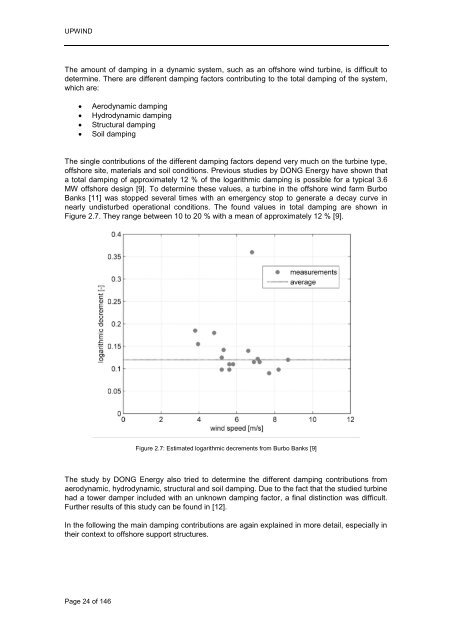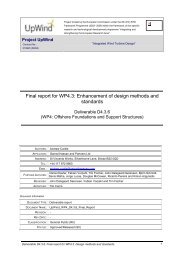You also want an ePaper? Increase the reach of your titles
YUMPU automatically turns print PDFs into web optimized ePapers that Google loves.
UPWIND<br />
The amount of damping in a dynamic system, such as an offshore wind turbine, is difficult to<br />
determine. There are different damping factors contributing to the total damping of the system,<br />
which are:<br />
� Aerodynamic damping<br />
� Hydrodynamic damping<br />
� Structural damping<br />
� Soil damping<br />
The single contributions of the different damping factors depend very much on the turbine type,<br />
offshore site, materials and soil conditions. Previous studies by DONG Energy have shown that<br />
a total damping of approximately 12 % of the logarithmic damping is possible for a typical 3.6<br />
MW offshore design [9]. To determine these values, a turbine in the offshore wind farm Burbo<br />
Banks [11] was stopped several times with an emergency stop to generate a decay curve in<br />
nearly undisturbed operational conditions. The found values in total damping are shown in<br />
Figure 2.7. They range between 10 to 20 % with a mean of approximately 12 % [9].<br />
Page 24 of 146<br />
Figure 2.7: Estimated logarithmic decrements from Burbo Banks [9]<br />
The study by DONG Energy also tried to determine the different damping contributions from<br />
aerodynamic, hydrodynamic, structural and soil damping. Due to the fact that the studied turbine<br />
had a tower damper included with an unknown damping factor, a final distinction was difficult.<br />
Further results of this study can be found in [12].<br />
In the following the main damping contributions are again explained in more detail, especially in<br />
their context to offshore support structures.











